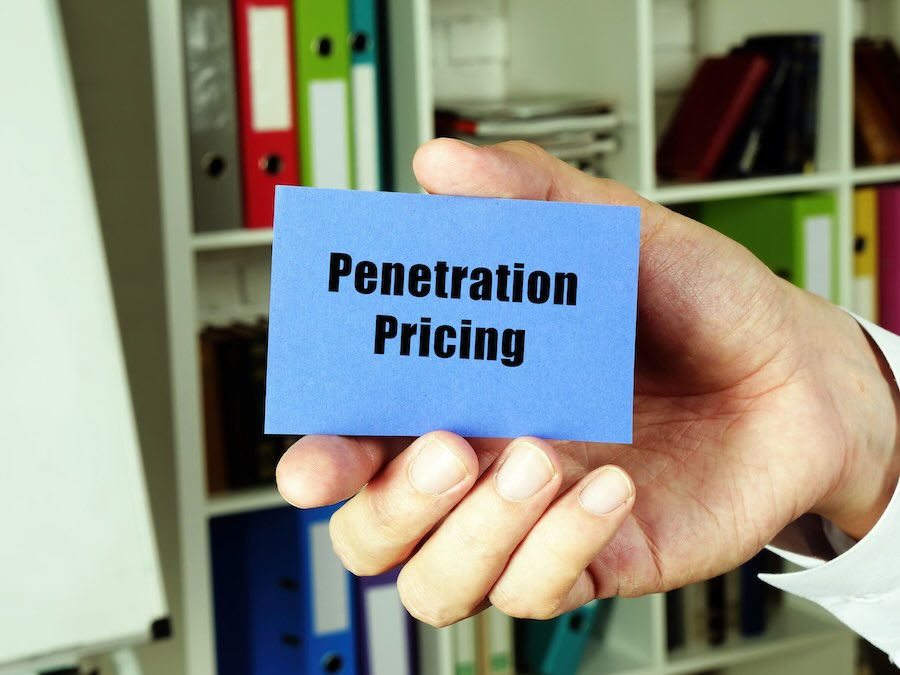
Penetration pricing is a method used by businesses entering a market with a new product or service. It’s characterized by offering significantly lower prices compared to competitors at first, then strategically increasing prices to a more sustainable level. It’s particularly effective in competitive markets, enabling businesses to stand out among established brands and capture consumer attention.
In this article, we’ll cover what penetration pricing is, how it works, who uses it, and helpful tips for your business’ penetration pricing strategy.
Understanding Penetration Pricing
While there are many different retail pricing strategies tailored toward various objectives, penetration pricing aims for rapid market entry, immediate growth in market share, and the creation of a foundation for long-term customer loyalty.
To implement penetration pricing, businesses set their initial prices low after carefully considering factors such as cost, competition analysis, and market demand, ensuring the price is appealing yet sustainable in the scheme of the rest of their penetration plan. They then gradually increase prices to maximize profitability while maintaining the customer base acquired at the beginning, carefully balancing the transition to avoid losing customer loyalty.
This strategy is commonly used to launch new products or services, aiming to gain consumer interest by making it easy to try something new at a minimal cost. The success of penetration pricing depends on knowing how customer demand responds to price changes and understanding the competition, while highlighting a unique offer.
Example:
Say a company introduces a smartwatch with advanced health tracking features. To quickly gain market share and outcompete its rivals, they price it at $99—well below the market average—despite higher production costs. As the business secures market dominance and builds brand loyalty from customers buying at the low price point, they slowly raise the smartwatch’s price, aligning with its value and recovering the initial investment.
Pros & Cons of Penetration Pricing
Penetration pricing not only speeds up market entry but can position your brand above competitors. However, like any strategy, penetration pricing comes with its own set of challenges and considerations. Here are the main advantages and disadvantages that come with it:
Pros of Penetration Pricing
Rapid market entry: Lower price points can quickly draw attention to a new product or service, making it easier and faster to enter the market and gain market share.
Building a customer base: Attractive pricing encourages potential customers to try a new product, helping to build a substantial customer base quicker than traditional pricing strategies.
Enhanced brand awareness: The buzz generated by low pricing can significantly increase brand visibility and awareness, laying the groundwork for future retail marketing efforts.
Opportunity for market dominance: If effectively done, penetration pricing can lead to market dominance, as buyers become accustomed to the value proposition of your product.
Disruption of competitors: By setting lower prices, emerging companies can disrupt existing market dynamics, prompting competitors to rethink their pricing and market strategies.
Economies of scale: An increase in sales volume can lead to economies of scale, reducing the cost per unit and improving margins over time.
Cons of Penetration Pricing
Short-term financial strain: Operating at lower margins—or even at a loss—can put significant financial strain on a company, especially a startup. This is particularly harmful if the strategy does not result in the anticipated market share gains.
Risk of price wars: Competitors may respond with price cuts of their own, leading to price wars that can erode profitability for all players in the market.
Customer perception: Customers who take notice due to your low prices may perceive the product or service as low quality, or may become disgruntled when prices are raised to higher levels.
Reliance on volume: The success of penetration pricing often relies on high sales volumes, and failure to achieve these volumes can result in financial losses.
Potential for brand damage: If not carefully managed, the transition from low to higher prices can damage brand reputation and customer loyalty.
Difficulty in raising prices: Customers who come on board during the penetration phase may resist price increases, leading to challenges in adjusting for long-term viability or a lack of loyalty in your customer base.
Who Should Use Penetration Pricing Strategies
Penetration pricing is a tactical approach that can benefit certain types of businesses while posing challenges for others. It’s a strategy that requires careful consideration of the market and the product or service being offered.
When to Use Penetration Pricing
- Introducing a new product: Brands launching a new product, service, or offering can use this method to secure a place in the market and garner consumer interest quickly.
- Highly competitive markets: Companies in sectors with established players can use the penetration pricing strategy to carve out market share by offering comparable offerings at a lower price.
- High-volume, low-cost production: Businesses that can achieve economies of scale and maintain profitability even at lower price points are well-positioned to leverage penetration pricing.
- Innovative and disruptive solutions: Startups and companies introducing new products that significantly differ from existing solutions can use penetration pricing to encourage trials and build an eager customer base.
- Rapid market expansion: Companies looking to quickly expand their market presence and customer base can use penetration pricing to accelerate growth and establish a strong position.
- Strong finances: Businesses that can afford temporary reductions in profit margins or initial losses are well-suited for penetration pricing.
When Not to Use Penetration Pricing
- Niche markets: For products or services with a niche market, the reduced margins from low pricing may not expand the customer base enough to compensate.
- Premium brands: Luxury or premium brands that rely on high prices as part of their value proposition risk diluting their brand perception and alienating their target market with penetration pricing.
- Products with high production costs: Businesses with products that have high production costs may find it challenging to sustain the low pricing needed for effective penetration pricing without compromising quality or finances.
- Limited product runs or short-term offerings: Penetration pricing is designed for long-term market share growth, not quick sales boosts. Limited-time products might not recoup the initial costs of production and low introductory prices.
Implementing a successful penetration pricing strategy involves more than just setting a low price for your products or services. It’s a complex approach that requires careful planning and execution to ensure you not only attract customers initially but also retain them in the long run— even as prices adjust. Here are some tips and strategies to consider:
1. Evaluate Financial Impact
Make sure that your company can withstand the initial period of lower profit margins involved in penetration pricing without compromising its financial stability—especially if you’re starting a new business. This might involve reevaluating your budget, identifying areas for cost reduction, or improving supply chain efficiencies.
2. Understand Your Market & Competition
Before implementing a penetration pricing strategy, conduct an exhaustive market analysis to understand consumer needs, price sensitivity, and the competitive landscape. Knowing what competitors are doing price-wise and the value they offer can help you set your initial prices strategically—not just lower.
3. Set Clear Objectives
Define what success looks like for your penetration pricing strategy. Is it a certain market share percentage, a specific number of new customers, or hitting a particular revenue target within a time period? Setting clear, measurable objectives helps in designing a pricing plan that aligns with your overall business goals and provides a benchmark for evaluating its effectiveness.
4. Price Sensitively
One of the critical aspects of a penetration pricing strategy is the gradual increase in prices to more sustainable levels. It’s essential to plan for these adjustments carefully—abrupt or significant price hikes can lead to customer churn. Instead, opt for gradual increases, and consider coupling them with enhancements in product value or customer service to justify the higher cost.
5. Communicate Value Clearly
It’s important to convey the value your product or service offers beyond just a lower price. Highlight features, benefits, and any unique selling propositions that make your offering stand out. As you plan for gradual price increases, reinforce the value delivered to justify the higher price points to your customers.
6. Monitor Competitor Responses
Keep a close eye on how your competitors respond to your penetration pricing strategy. If they start lowering their prices too, it could lead to a price war, which is typically harmful to all involved. Instead, focus on differentiating your offering in other ways—such as superior customer service or additional features—to maintain your competitive edge without relying solely on price.
7. Monitor and Adapt
Market conditions, consumer preferences, and competitive actions will evolve. Continuously monitor these changes and be prepared to adapt your strategy accordingly. Regularly review your pricing strategy’s performance against the set objectives and make data-driven decisions to adjust pricing, marketing, and product development efforts.
Real-world Examples of Penetration Pricing
Penetration pricing is a common tactic in the retail, restaurant, and software as a service (SaaS) industries. These are some of the top brands that have leveraged penetration pricing in their winning business strategies:
Netflix
Netflix exemplifies penetration pricing’s success in the streaming world. After securing its place as market leader, Netflix has maintained a loyal viewership despite occasional price hikes. With a significant share of the US streaming market, Netflix’s approach has not only solidified its leadership but also set a standard for other streaming platforms to follow.
Samsung
Samsung uses penetration pricing to differentiate itself in the competitive smartphone market. By offering high-quality devices at lower price points than its premium competitors, Samsung makes its technology accessible to a wider audience. This strategy not only boosts its market share but also builds customer loyalty through affordable innovation. As new models are introduced, Samsung strategically prices older versions to maintain appeal across various consumer segments, ensuring continued revenue growth and brand presence.
Starbucks
As a leader in the premium coffee market, Starbucks strategically uses penetration pricing to launch its new and seasonal beverages. By offering these products at lower prices initially, Starbucks encourages customers to try something new. Once the items become established and gain a following, Starbucks gradually removes the introductory offers, integrating these products into their menu at regular prices. This tactic not only attracts customers looking for novelty but also helps in maintaining the brand’s image of innovation and quality.
Gillette
Gillette has successfully used penetration pricing within the consumer goods sector by selling razors at low costs—or even giving them away. This approach has helped maintain its market dominance. The lower revenue from razor sales is offset by the higher margins from selling razor blades and accessories at premium prices, ensuring a wide customer base and sustained revenue from these add-ons.
Kroger
This grocery giant implements penetration pricing strategies specifically for its organic product lines. Recognizing the higher profit margins available on organic goods and the ability to achieve economies of scale, Kroger introduced these products at lower prices. This approach boosts demand and sales volume, allowing the chain to reap significant profits despite the initially reduced prices.
Penetration Pricing vs Price Skimming
While penetration pricing focuses on setting low initial prices to attract a broad customer base in competitive markets quickly, price skimming uses the opposite tactic.
Price skimming involves setting high initial prices for new, innovative, or highly differentiated products with minimal competition. This strategy targets early adopters willing to pay a premium for the novelty or exclusivity of the product. As the product matures and competition enters the market, companies gradually lower the price to capture wider segments.
The key difference lies in their objectives: Penetration pricing seeks rapid market entry and volume sales, aiming for long-term customer acquisition, whereas price skimming aims to maximize short-term profits before wider market adoption necessitates price reductions.
Frequently Asked Questions (FAQs)
These are some of the most common questions people have around penetration pricing.
Penetration pricing can be effective for breaking into competitive markets and quickly securing a customer base. However, it’s not the best fit for every situation. It works for products that appeal to a broad audience in markets sensitive to price changes, as long as the company can manage the initial lower profit margins and scale up production as needed.
Penetration pricing involves initially setting lower prices to attract buyers, with the intention of raising prices once customers are interested. Economy pricing, on the other hand, consistently maintains low prices to attract the most price-sensitive segment of the market, operating on thin profit margins without planning for price increases.
Companies including Netflix, Disney+, Samsung, Gillette, Starbucks, and many popular banks have used penetration pricing to their advantage.
Bottom Line
Penetration pricing is a powerful method for businesses aiming to enter and make an impact in a new market quickly. That said, companies must carefully assess their market, operational strengths, and long-term goals when considering penetration pricing as a strategic option.
By following these tips and maintaining a focus on long-term customer value and satisfaction, you can leverage a penetration pricing strategy to not only enter a market successfully but also build a strong, loyal customer base that will support your business as it grows and evolves.





